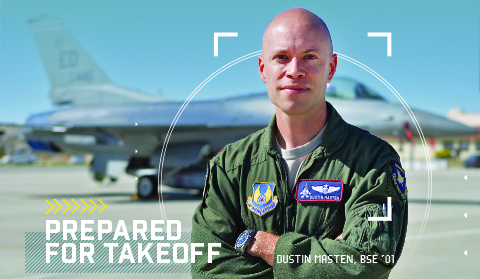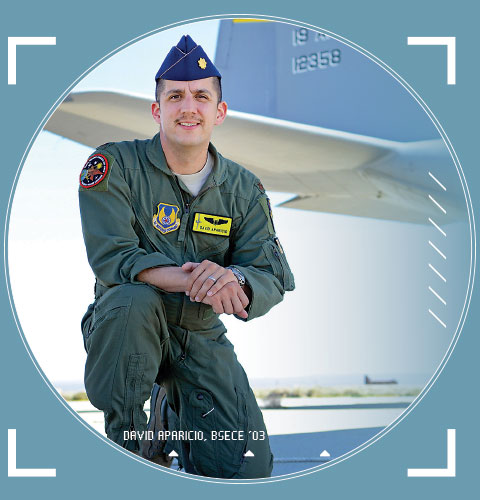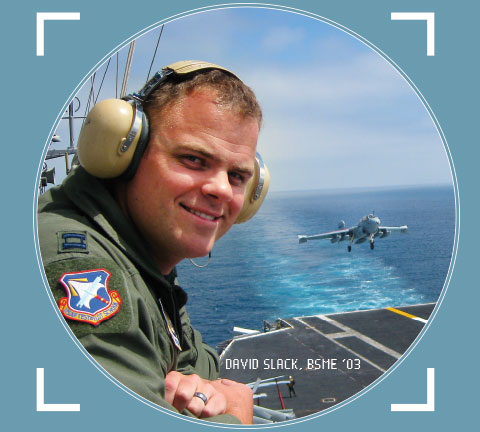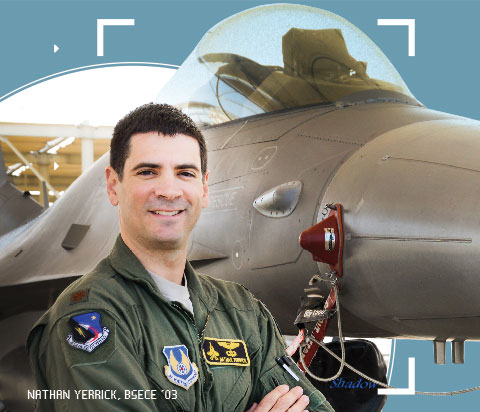Flight paths
"The best year that I never want to repeat" is an oft-quoted phrase that echoes through the hallowed halls of the U.S. Air Force Test Pilot School (TPS) at Edwards Air Force Base in Southern California—where only the Air Force's best and brightest pilots, engineers and navigators come to learn how to perform test flights and evaluate the data critical in completing test-flight missions.
At one of the world's elite training and educational centers for flight-test engineering and evaluation, there's no room for second-best, no time for excuses and no chances for do-overs. Every year, thousands of highly qualified candidates vie for a handful of open spots on its rosters. Those gaining admittance stand at the top of their class in academics, flying abilities, experience and officership, among other benchmarks.
And being accepted to TPS—whose past commandants include such aerospace legends as Buzz Aldrin and Chuck Yeager—is not the hardest part.
The rigors of TPS training begin on day one of an intense 48-week program that puts each student's skills to the test in the areas of performance, flying qualities, systems and test management. Each year, on average, TPS awards degrees to graduating classes of fewer than 25 students who have proven to have "the right stuff:" cutting-edge expert knowledge, laser-sharp flying and engineering skills, sound judgment and unwavering bravery.
The short list of TPS graduates who possess those highly coveted skills and exceptional character holds at least four Baylor alumni whose careers first took flight through Baylor's competitive School of Engineering and Computer Science (ECS) and Baylor's recognized Air Force Reserve Officers Training Corps (ROTC) program:
Majs. Dustin Masten, BSE '01, David Aparicio, BSECE '03, David Slack, BSME '03, and Nathan Yerrick, BSECE '03.
From the time he was a young boy, Maj. Dustin Masten knew the direction in which he wanted to take his career, although he didn't always know that direction would be up tens of thousands of feet in the sky. Born into a family with a long line of military men—including his father, who served in the U.S. Air Force, and both of his grandfathers, who served as master sergeants in the U.S. Army—Masten had dreamed of following in the footsteps of his heroic family members by forging his future in the military.
"I've always had that same sense of obligation and desire to serve my country," Masten. He adds that his late grandmother reserved one wall in her home to display the photos of all the family members who served in the military, and he hoped that he would share the honor of having his photo hanging on that wall. "I am very fortunate to have the ability to serve; it means the world to me."
The first step along that path of service began in fall 1997 at Baylor. While touring the campus, Masten immediately felt a connection. "It was a great campus and [Waco] a great city. There was a sense of community, and I knew this was a place that I could call home," says Masten, who hails from San Antonio. "I was also attracted to Baylor for the low student-to-faculty ratio; I didn't want to be just a face in a crowded classroom," he adds. "I knew that I wanted to serve in the Air Force and be an electrical engineer, and I was also looking for an interactive learning environment."
Masten, along with fellow alumni Aparicio, Slack and Yerrick, found that collaborative learning environment in ECS, which offers accredited programs in electrical and computer engineering, general engineering, mechanical engineering, computer science, and bioinformatics, as well as graduate programs leading to Master of Science degrees in all disciplines and a doctoral degree in electrical and computer engineering. ECS is renowned for its dynamic and demanding curriculum, small class sizes, and accomplished faculty members—some 30 throughout the engineering programs—who are committed to excellence in teaching and research and who know students by name. ECS students frequently outperform students from other engineering programs in Texas with a higher passing rate on the Fundamentals of Engineering exam. ECS students also have won the annual Association of Computing Machinery International Collegiate Programming Contest, with ECS serving as the contest's headquarters for more than two decades and as the host university in 2006.
In recent years, eyes have focused on the developing Baylor Research Innovation Collaborative (BRIC), part of a 50-year master plan development of a 21-acre property—and potentially 750,000 square feet of building space—that serves as the cornerstone of the Central Texas Technology and Research Park. The BRIC not only provides space for research centers, wet and dry labs, workforce training and academic symposia, but it fosters opportunities for interdisciplinary collaboration—particularly for those from the science, technology, engineering and mathematics (STEM) disciplines, including research space for students pursuing a PhD in electrical engineering.
These hallmarks that have helped ECS, which celebrates its 20th anniversary as a school next year, earn the honors of being ranked in the top 25 of the "Best Undergraduate Engineering Programs" in the nation by U.S.News & World Report.
These four veteran cadets also honed their leadership, management and communications skills through Baylor's Air Force ROTC program, which helps prepare students to become officers in the U.S. Air Force through the two-year General Military Course, two-year Professional Officers Course, leadership development labs and field training, offering them scholarships in return for a period of active duty (the length of which varies according to commission). Since its inception in July 1948, Baylor's Detachment 810 Cadre—one of the first in the nation—has commissioned more than 1,300 pilots, engineers, doctors, nurses, space-support officers, combat-systems operators, air-battle managers, and dozens of other second lieutenants in mission-support career fields. In 1996 and 2003, Baylor's Detachment 810 garnered the High Flight Award, recognizing it as one of the top detachments in America and the best in the Air Force ROTC Southwest Region. In 2008, it was awarded the country's No. 1 large detachment, with some 100 cadets.
"Baylor taught me creative problem solving, which is essential in the military. The engineering program focused on developing general skills, not memorizing answers to questions," Masten says. "I thought [becoming a pilot] looked like a cool thing to do, but it was a long shot. So when the opportunity presented itself with the opening of a pilot slot, I dove into it."
The opportunity came knocking with Euro-NATO Joint Jet Pilot Training at Sheppard Air Force Base in Wichita Falls, Texas, where Masten also earned honors as the top academic graduate. He has completed training for flying the F-15E Strike Eagle tactical fighter at Seymour Johnson Air Force Base in Goldsboro, N.C., where he landed top academic graduate honors again; flown the F-15E at the Royal Air Force Base Lakenheath in the United Kingdom; and served as an instructor pilot at Laughlin Air Force Base in Del Rio, Texas.
His experiences at TPS helped him spread his wings to fly dozens of leading-edge and vintage military aircraft, from the F-18 Hornet to the MiG-15 to the UH-72 Eurocopter. "One of the highlights for me [at TPS] was flying an A-10 [Thunderbolt II] in Arizona," Masten recalls. "After just three days of training, I was flying the A-10 to a bombing range." Among his experiences, Masten participated in G-suit testing, albeit with a medical setback: He broke his rib when the suit shifted.
In fall 2005, just a few short years after graduating with honors from Baylor, Masten was serving his country in a combat tour in Afghanistan and Iraq, completing more than 40 successful flying missions and some 300 combat hours. Today, stationed at Edwards Air Force Base, he is one of only two government pilots flying the F-15 SA fighter jet. After 13 years of service, he is working to accomplish the next step on his flight path: transitioning to a civilian flight-test or commercial-airline pilot job.
Securing the Future
For Maj. David Aparicio, seeing his future as a flight-test engineer was not always crystal-clear. Growing up in Sugar Land, Texas, with an early interest in science—biology, in particular—he had set his sights on a career in the field of medicine. A slew of medical reality shows in the late 1990s—with a profusion of blood playing a lead role—helped him reconsider his choice of medicine as a career field. Aparicio, who also enjoyed calculus and physics, attended an orientation on Baylor's campus and was offered an ROTC scholarship by the U.S. Air Force to study electrical engineering, an offer he quickly accepted.
"The game plan after graduating from Baylor was to give the Air Force [the required] four years. That was in 2003. I've been here for more than 10 years," Aparicio says. He adds that he plans to continue in his role as a flight-test engineer in the 412th Test Wing at Edwards Air Force Base, where he specializes in aircraft performance, systems testing and cyber security. His duties include engineering flight tests of remotely piloted aircraft such as the RQ-4 Global Hawk, an unmanned aerial-vehicle surveillance aircraft, and modifying other military aircraft to optimize performance.
Shortly after completing an advanced course in engineering in cyber security and attaining his master's degree in electrical engineering from Southern Methodist University in Dallas, Aparicio, at the age of 23, was bestowed the privilege of testifying before Congress about the critical need for cyber security education. For him, that education was launched in Baylor's ECS and Air Force ROTC programs.
"The Baylor engineering program taught me a good work ethic and attention to detail," Aparicio says. "You have to slow down and solve the problem; there's no partial credit.
"Details are extremely important when you're working on multi- million-dollar aircraft and projects. It's not as important to be the smartest guy as it is to be the one who works the hardest."
Aparicio, too, earned his wings attending TPS, where he flew 25 different types of aircraft, from supersonic fighters to WWII trainers to seaplanes and gliders, with air time exceeding 100 hours. "Within just one week [at TPS], I flew a Cessna, a T-38 Talon and an F-16 Fighting Falcon. My last flight was in the Goodyear Blimp," he says.
Without the critical groundwork, the flight missions could never take off. For every minute in the air are countless hours of painstakingly detailed planning and evaluation on the ground. "We'd fly in the morning and then land to attend classes in the afternoon. [Working on the aircraft] is like working in a physics lab on steroids; you're limited on gas and airspace, so you need a game plan—a strategy between you and the pilot," Aparicio says. "[Flight-test missions] are 95 percent preparation, 5 percent flying."
The amalgam of that vital training and education helped prepare Aparicio for a six-month tour in 2009 in Afghanistan, where he neutralized Improvised Explosive Devices (IEDs) targeting U.S. Army trucks, preventing them from blowing up—and saving people's lives. "Going to Afghanistan and helping to keep the team safe in that tough environment means more to me than anything," Aparicio says.
He recalls being in physical training in Baylor's Air Force ROTC program when the 9/11 terror attacks occurred in 2001. "We [the cadets] all knew at that moment that something big was happening and had a sense that this would affect our future. When I joined the Air Force in April 2000, we didn't have a precise enemy in mind. [In the aftermath of the attacks], our focus became keeping our country safe.
"I feel appreciative that I've gotten all of these unique experiences," Aparicio says. "The Air Force has paid for [my education], and the country gets my technical talents."
Soaring Goals
As a high-school student in Omaha, Neb., Maj. David Slack considered a career in medicine and mulled over whether to major in pre-med or engineering in college. When he tagged along with a friend to visit Baylor and immediately clicked with several Air Force ROTC cadets on campus, his choice became clear. Soon after that serendipitous visit, Slack was awarded an Air Force ROTC scholarship to study engineering in ECS.
"When I compare experiences with other engineers across the services, I realize how lucky I am to have gone to a school like Baylor," says Slack, who minored in mathematics. "The academic program at Baylor was top-notch, and the professors took a personal interest. … The one-on-one attention from professors and the challenging workload built and honed my problem-solving and critical-thinking skills.
"Baylor fostered a balance of spiritual, academic and social aspects of your life," he adds. "Learning that balance, particularly keeping God centered in my life, allowed me to make good choices and excel in whatever I did."
Slack excelled at Baylor, and his 10-plus-year career is marked with many milestones. Those include earning his master's degree in aeronautical engineering with an emphasis in air breathing and rocket propulsion from the Air Force Institute of Technology at Wright-Patterson Air Force Base in Dayton, Ohio; serving as an A-10 Thunderbolt II structural engineer; serving as an air battle damage repair engineer for the A-10, F-16 Fighting Falcon and F-117 Nighthawk at Hill Air Force Base in Ogden, Utah; and testing the A-10C Warthog, F-22 Raptor and F-16 at Nellis Air Force Base in southern Nevada. Of course, graduating from TPS with a master's degree in flight test engineering is among the top of his of accomplishments.
"I didn't realize engineers could go to Test Pilot School until I was at my first assignment. Once I learned it was possible, that was my goal," says Slack, who had often talked with his Baylor college roommate Nathan Yerrick about their aspirations of attending TPS. "Test Pilot School was one of the best years of my life. My only responsibilities were to learn about airplanes, fly in airplanes—all kinds, 27 different airplanes in total—and hang out with 23 other people who shared the same interests. … The ultimate goal of TPS is to learn to safely and effectively test all aspects of an aircraft. The school teaches engineering appreciation to pilots and pilot appreciation to engineers."
As part of his training, Slack participated in a one-week exchange program with the Empire Test Pilots' School in Wiltshire, England. "We flew [British] aircraft and practiced techniques we learned in the first six months of class," he says. "All in all, [TPS] was a great experience, and I developed a bond with my classmates that will last a lifetime."
Slack also shares an enduring bond with his former fellow cadets in Baylor's Detachment 810. They were in class on an ROTC uniform day watching the horrific news of the 9/11 attacks unfold on a television. "I sat in disbelief," he recalls. "I visited Ground Zero a year later and still remember the notes and pictures of the people lost that day.
"Many of the projects I have worked on were a direct result from the 9/11 attacks," he adds. "We remember [all those lost ones] all the time in my squadron." Slack is working in flight-test coordination in Las Vegas, Nev., and this summer he will return to Wright-Patterson Air Force Base to work in program management, using his technical skills in service to our country.
"My true privilege and satisfaction is knowing my work has and can directly help troops on the ground," Slack says. "They are the true heroes, putting themselves in harm's way."
Answering the Call
Technical talents were a gift that Maj. Nathan Yerrick was looking to apply in an academic setting that was near his Texas hometown, and one that was rooted in the Christian tradition. He found that—and more—when he looked to Baylor.
"I grew up in south Fort Worth, so [Baylor] was really close to home, which was a good thing. But primarily, the fact that Baylor was faith-based not in name only but in action was attractive. Also, [Baylor] had a strong engineering and ROTC program," says Yerrick, adding that the Baylor community believes and acts on what it professes.
While Yerrick arrived at Baylor majoring in electrical engineering on an ROTC scholarship, he didn't know the precise path that his career would take at the time; what he did know was that his demanding education at Baylor would set the stage for personal success.
"My engineering education at Baylor was the most rigorous academic education I have received to date. It taught me the fundamentals I needed to succeed in the future, and more importantly, it taught me how to learn, even if I wasn't using the exact information that I was taught," Yerrick says. "Also, the nice balance between collaboration and individual effort helped me prepare for what's expected in the Air Force."
Since graduating from Baylor, Yerrick has conducted lab research at Eglin Air Force Base in Valparaiso, Fla., where he worked on mini unmanned aerial vehicles (UAVs), with his research being published in a technical journal. He also served at an operational test squadron with all types of fighter aircraft, including much of his work managing modifications and instrumentation on the F-22 Raptor stealth fighter, and worked as a test conductor in the developmental test of the F-35 Joint Strike Fighter Lightning II. And, of course, Yerrick spent "the best year that he never wants to repeat" at the prestigious TPS.
"It was an incredibly exciting, rewarding and exhausting year. I flew over 33 different types of aircraft, from old to new, from props to jets, from fighters to heavies," says Yerrick, noting that any given week would require three to five flights, three to four reports, a weekly academic test and a flight simulation. "Some of the more exotic aircraft that we got to fly were the MiG-15, Fouga Magister, Goodyear Blimp, HU-16 Albatross (an amphibious rescue plane from WWII) and seven types of helicopters. Then there were the more usual types of military aircraft such as the F-16 [Fighting Falcon], T-38 [Talon], KC-135 [Stratotanker] and C-12 [Huron]."
One of his projects also involved working with the U.S. Department of Homeland Security to improve the detection of small, low-flying aircraft trying to breach our borders.
"All the different aircraft were amazing, but the best part about [my experience at TPS] was my classmates," he adds. "I have never—and probably will never again—work so closely with 23 amazing individuals that love flying and believe in the Air Force's mission."
Yerrick currently serves as a test wing executive officer on the administration side of operations at Edwards Air Force Base. When asked what it means to him to be able to serve his country, he replies: "It's a very abstract concept. I wake up and go to work just like anyone else. I'm concerned about the same things every American is concerned about: my kids, their education, where we're going to live next, etc. But it's an honor to be a part of something that I believe in, a part of something that I know is protecting my family and the nation."
That sense of duty was brought into sharp focus for Yerrick during the 9/11 terror attacks. At the time, he was in the Air Force ROTC program at Baylor and was delivering The Lariat on campus when he heard the tragic news.
"I think I felt much like many of my fellow Americans: infuriated and saddened. Our nation had not been involved in any major conflicts for some time, so I think it gave focus to the cadets in our detachment," Yerrick says. "We knew why we were joining the Air Force, and we believed we could make a difference in making our nation safe against terrorism. Ten years later, many of my fellow classmates have seen combat in the war against terrorism, and all have contributed to our nation's security in one form or another."
While Majs. Yerrick, Slack, Aparicio and Masten have blazed different trails in their careers, with their paths crossing and lives intersecting at times throughout the past decade, they share a steadfast commitment to serving our nation through the giving of their education, technical skills and personal qualities that make them standouts in their field.
"[Serving in the Air Force,] I'm always reminded that freedom isn't free," Masten says. "So many have given up so much to preserve the freedom that we all enjoy, and I'm thankful for their sacrifice."
The Baylor family thanks and salutes the majors and all who have served and continue to serve in our armed forces for their service and sacrifice. As it's said in the Air Force: "Fly.Fight.Win."



